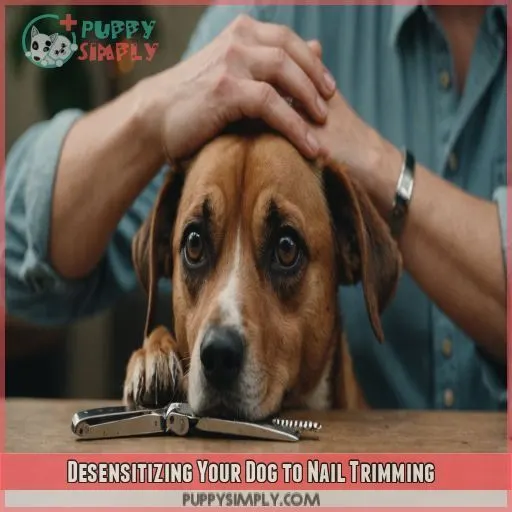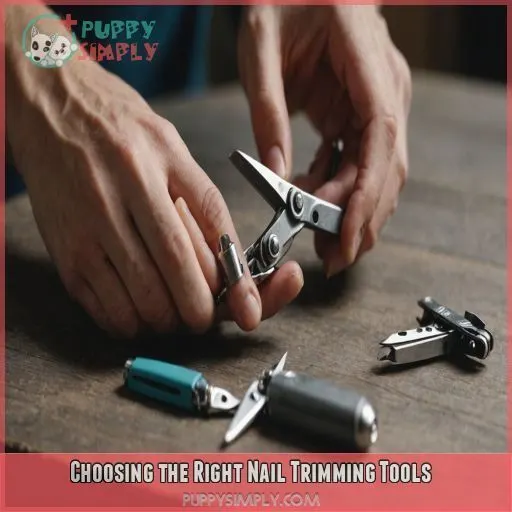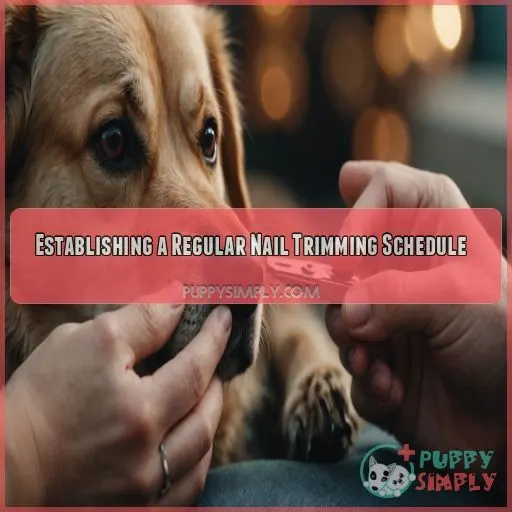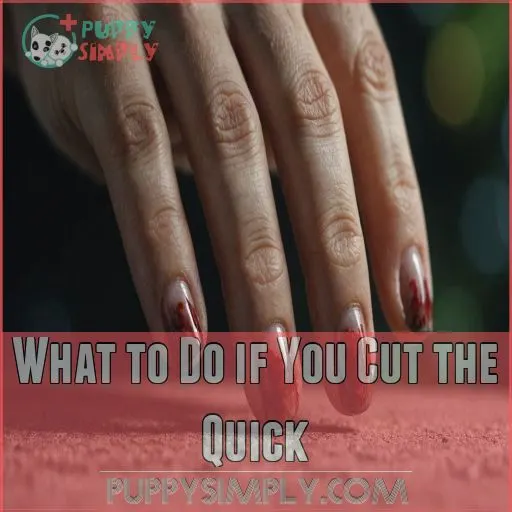This site is supported by our readers. We may earn a commission, at no cost to you, if you purchase through links.

Start by gently desensitizing your pup to the process using treats and kind words.
Choose the right tool: guillotine clippers are beginner-friendly, while scissor-types work like magic for short nails.
Trim small sections, carefully avoiding the quick (think of it as avoiding that pesky toe stub!).
If your dog gets antsy, take a breather.
Stay tuned for more pawsome tips on helping Fido’s nails stay shipshape!
Table Of Contents
- Key Takeaways
- Why Overgrown Dog Nails Are a Problem
- Desensitizing Your Dog to Nail Trimming
- Choosing the Right Nail Trimming Tools
- Safely Trimming Overgrown Dog Nails
- Establishing a Regular Nail Trimming Schedule
- What to Do if You Cut the Quick
- Grooming Tips for Healthy Dog Nails
- Trimming Nails on Anxious or Aggressive Dogs
- Dealing With Severely Overgrown Dog Nails
- Making Nail Trimming a Positive Experience
- Frequently Asked Questions (FAQs)
- How to trim a dog’s nails when they are too long?
- How do you treat severely overgrown dog nails?
- How do you cut overgrown dog nails that are curled?
- How do you trim my dog’s nails when he won’t let me?
- Can overgrown nails lead to infections?
- How often should dogs nails be checked?
- What signs indicate discomfort from long nails?
- What are alternatives to trimming at home?
- Is nail trimming painful for dogs?
- Conclusion
Key Takeaways
- Don’t let your dog’s nails turn into comedy-sized claws. Regular trims help prevent painful foot problems, better posture, and the chance of their nails crafting a slapstick routine on your carpet.
- Get your grooming game face on – the right tools make all the difference. Use guillotine clippers for newcomers, but if you’re going for a scissor-type, precision is your wingman.
- Nail trimming can feel like trying to do yoga with a hyperactive toddler, but patience is your best friend. Use treats, soothing words, and maybe your finest pup-whisperer impersonation to make nail time a zen time.
- If trimming feels like a wrestling match every time, don’t hesitate to tag in professional groomers or your vet for a spa-like, stress-free session.
Why Overgrown Dog Nails Are a Problem
When your dog’s nails become overgrown, it’s not just a grooming issue; it’s an invitation to pain, foot deformities, and a clumsy gait that can have your pooch tripping over themselves like a comedy act.
Keeping those nails trimmed prevents infections and tangles.
It also helps your furry friend strut their stuff like the graceful pup they’re meant to be.
Pain and Discomfort
Ever wondered why your pup’s walking like they’re in a three-legged race? Its overgrown nails causing paw pain and discomfort. Trim regularly to reduce pressure on feet and prevent limping. Nail trimming’s really important!
Foot Deformities
Overgrown nails can distort your dog’s feet, harming tendons and causing foot deformities. Proper nail trimming is really important to maintain your pup’s paw health and comfort.
Tangling and Infections
Imagine your dog’s nails as tiny stubborn hedgehogs. If they grow too long, they might get snagged on carpets, leading to injuries or infections. Regular nail trimming and a good paw care routine prevent these hazards.
Gait and Posture
An overgrown nail can throw Rover’s body mechanics out of whack, leading to joint pain and walking difficulties. Imagine wearing shoes several sizes too big—awkward, right?
- Affects gait
- Impacts posture
- Causes discomfort
- Alters paw health
- Disrupts balance
Desensitizing Your Dog to Nail Trimming
If you’re dealing with a dog who hates nail trims, you’re not alone—think of it like trying to give a cat a bath! By using treats and your best acting skills as a dog whisperer, you can turn nail trimming from a nightmare into a manageable task.
Positive Reinforcement
Reward your pup with tasty treats and enthusiastic praise during the nail trimming process. Use a clicker to mark positive behaviors – this helps your dog associate the experience with something enjoyable. Stay consistent and patient; it may take time, but building trust is key to making nail trims a breeze.
Patience and Understanding
Building trust with your furry friend is like painting a masterpiece—it’s all about patience and understanding. Keep calm when handling anxiety in nail trimming. Remember, Rome wasn’t built in a day!
- Dog behavior: Observe cues to help ease nerves swimming safety concerns.
: Observe cues to help ease nerves.
- Calming techniques: Use soothing voices and gentle touches.
- Positive reinforcement: Celebrate small victories with treats!
These steps pave the way to smooth pet grooming sessions.
Choosing the Right Nail Trimming Tools
Choosing the right nail trimming tools for your dog can feel like picking the perfect pair of shoes, but it makes all the difference in comfort and ease. Whether you’re a fan of clippers or grinders, making the right choice will have both you and your pup breathing a sigh of relief.
Dog Nail Clippers
Picking the right nail clippers for your dog is super important. You want clippers that are tough and safe so trimming their nails is easier.
Guillotine Clippers
Guillotine clippers are a great option for beginners – their simple, straightforward design makes them easy to use. Just be extra careful not to cut the quick.
Scissor-Type Clippers
Scissor-type clippers, ideal for short nails, offer precision. Think of them as tiny scissors for your dog’s paws—snip smartly, avoiding mishaps with safety tips!
| Feature | Best Use Case |
|---|---|
| Design | Short nails |
| Precision | High |
| Ease of Use | Moderate |
| When trimming your dog’s nails, be cautious not to cut the quick, as it can be painful and lead to bleeding, especially if your dog has been enjoying tasty mochi treats. | Essential to prevent cutting the quick |
Clamp-Type Clippers
While scissor-type clippers suit short nails, clamp-type clippers are for professional use—great for bigger breeds with tough nails.
- Robust and precise
- Suitable for thick nails
- Professional-grade control
- Safer for big dogs
Dog Nail Grinder
Clamp-type clippers sound intimidating, right? Enter the dog nail grinder. This tool hums softly, offering gentle nail care. Grinder benefits? It’s versatile for cautious canines!
Safely Trimming Overgrown Dog Nails
Once your dog is comfortable with the nail trimming tools, it’s time to tackle those Overgrown nails. Just remember to take it slow, identify the quick, and use quick, decisive movements to avoid any mishaps.
Identifying the Quick
Now, let’s spot the quick—a small, pinkish area inside the nail. It’s like Mother Nature’s built-in “stop sign” and sensitive, so trim carefully!
Trimming Small Sections
After locating the quick, trim in small sections. Imagine you’re delicately slicing cake! Shorter clips are safer and reduce stress for both you and your pup.
Cutting at a Straight Angle
Think of the nail as a tiny branch. To prevent splitting or odd nail shape, trim at a straight angle. It’s like sculpting controlled nail growth!
Quick and Decisive Movement
Use a quick, decisive movement when trimming your dog’s nails to avoid accidents. This helps minimize discomfort and makes for a smooth, stress-free experience for your pup.
Stopping if Agitated
If your furball gets antsy, hit the pause button! Recognize stress signs and prioritize safety first. Use calming techniques and rewards to keep things positive.
Establishing a Regular Nail Trimming Schedule
If your dog’s nails sound like tap shoes on the floor, it’s time to rethink your trimming schedule. Regular nail trims help prevent discomfort and health issues, so set a routine that keeps those paws happy and healthy like a pied French bulldog.
, so set a routine that keeps those paws happy and healthy.
Weekly Trimming
Consistency is key when setting a weekly trimming schedule. Keep those nails in check, folks!
- Let quick recession guide you.
- Monitor nail growth rates.
- Enjoy shorter nail length goals.
- Your trusty trimming tools rock!
Ideal Nail Length
The ideal nail length allows your pup’s paws to rest comfortably on the ground when standing. Adjust this target based on your dog’s breed and the surfaces they walk on.
Adjusting Frequency
Tailor your trimming schedule to your dog’s nail growth rate. Different factors, like dog breed, lifestyle, age, and seasonal changes, can affect it. So, keep your clippers handy and always trust your instincts!
Veterinarian Consultation
If Fido’s nails seem to grow faster than a weed in summer, it might be time to chat with the vet. They’ll assess their growth and offer tips for maintaining nail health and trimming frequency.
What to Do if You Cut the Quick
Nobody’s perfect, and even the most careful groomer might accidentally cut the quick while trimming dog nails, causing a bit of bleeding and discomfort. Don’t worry—Fido won’t hold it against you if you’re prepared with a few tricks to stop the bleeding and keep your pup comfortable until their next spa day.
Stopping the Bleeding
If you accidentally cut your dog’s quick, don’t panic! Quickly apply styptic powder or cornstarch to stop the bleeding. Apply firm pressure with a clean cloth until the bleeding subsides. Seek veterinary care if bleeding persists.
Soothing the Discomfort
Oops, you cut the quick while nail trimming. No worries—just like us, dogs appreciate a soothing touch. Apply gentle pressure and styptic powder to stop the bleeding. Then, offer comfort and distraction with treats or gentle paw care, Then, offer comfort and distraction with treats or gentle paw care, using anxiety relief techniques.
.
Preventing Future Incidents
After easing your dog’s discomfort, prevent future incidents by knowing their unique nail growth rate. Consistent nail trimming frequency keeps their quick receding. Be the nail whisperer—watch those quick-sensitive areas! Read your dog’s moods—different breeds might need specific approaches. Keep learning—it pays pawsitively!
Grooming Tips for Healthy Dog Nails
Keeping your dog’s nails healthy is about more than just regular trimming; it’s also about good grooming habits. Make bath time a spa day for those paws, keep a nail file handy for touch-ups, and prevent overgrowth with a little TLC.
Bathing and Paw Care
Bathe your dog regularly to keep their paws clean and healthy. Apply a paw balm to soothe dry, cracked pads.
, cracked pads. Gently massage their feet to promote circulation and comfort. Proper paw care complements your nail trimming routine.
Nail File Maintenance
Keeping your dog’s nails in tip-top shape means using a nail file regularly. Here are some tips:
- Choose the best file brands for durability.
- File frequently to maintain healthy nails.
- Use various nail file types for different needs—experiment.
Preventing Overgrowth
Overgrown nails are a problem you can easily avoid. Nails grow at varying rates, so it’s important to keep an eye on them and trim them before they get too long. Regular trimming helps prevent overgrowth, discomfort, and joint issues.
Some dogs’ nails grow faster than others. Puppies’ nails, for instance, tend to grow rapidly, while older dogs’ nails may grow more slowly. You may need to trim a puppy’s nails weekly. Active outdoor dogs that spend time on concrete or hard surfaces may wear down their nails naturally, requiring less frequent trims.
A healthy diet with the right nutrients supports nail health. Include protein-rich foods, like meat and fish, and biotin-rich foods, such as eggs, cauliflower, and spinach, in your dog’s diet.
Breed also influences nail growth. Smaller breeds tend to have faster-growing nails, while larger, active breeds may wear them down naturally through play and exercise.
Exercise promotes proper circulation, ensuring the nail bed gets the nutrients it needs for healthy nail growth.
Trimming Nails on Anxious or Aggressive Dogs
Taming the wild side of nail trimming with anxious or aggressive dogs can be a real challenge, like trying to clip the toenails of a sleepy bear! But don’t worry—by using muzzle training and desensitization techniques, and knowing when to ask for veterinary assistance, you’ll make nail care less of a battle and more of a bonding moment.
Muzzle Training
For anxious or aggressive dogs, muzzle training can be a game-changer, making nail trimming safer. Here’s how to ease into it:
- Introduce the muzzle with treats.
- Make sure the muzzle fits snugly and comfortably.
- Use positive reinforcement.
- Practice calm handling techniques.
Desensitization Techniques
Gradually accustom your anxious pup to nail trims through positive reinforcement. Offer treats and praise during brief sessions, slowly increasing time and proximity to the clippers. This gentle desensitization will help ease their fears and make the process less stressful.
Veterinary Assistance
If your pup’s paws are a battleground, it might be time to call in the pros. Veterinarians provide expert advice on nail trimming issues, ensuring your dog’s nail health. Don’t let nail trim complications become ruff; seek professional help today!
Dealing With Severely Overgrown Dog Nails
When your dog’s nails resemble talons more than paws, don’t worry—you’re in good company. Tackling severely overgrown nails is like untangling a spaghetti knot, but with gradual trimming and perhaps a vet’s touch, you can prevent future nail calamities.
Gradual Trimming
Gradual trimming is like gently easing into a cold pool, slow and steady. Take itty-bitty snips, respecting the quick’s boundary. Each careful clip brings you closer to ideal nail length. Emphasize patience and persistence, using desensitization to make the experience less overwhelming for puppy nails.
Veterinary Intervention
If your dog’s nails are severely overgrown, veterinary intervention may be necessary. Your vet can:
- Safely trim the nails
- Treat any underlying issues
- Provide pain medication
- Recommend a nail care routine to prevent future neglect.
Preventing Future Neglect
You’ve tackled severely overgrown nails. Let’s not let this fur-midable task claw its way back! Establish a solid dog nail trimming routine. Remember these signs of neglect:
| Signs | Frequency | Resources |
|---|---|---|
| Long nails touch the floor | Weekly | Vet guidance |
| Limping | Bi-weekly | Online tutorials |
| Clicking sound | Monthly | Owner education |
Making Nail Trimming a Positive Experience
Turning nail trimming into a positive experience can make the process much easier for both you and your furry friend. By using treats, calming techniques, and building trust, you’ll soon find nail trimming less like a wrestling match and more like a spa day.
Treats and Rewards
After managing those jungle-like nails, it’s time to sweeten the deal with some treats. Timing is everything—reward your dog promptly for staying calm. Mix it up with their favorite snacks to keep them keen. A little variety goes a long way!
Calming Techniques
Soothing music, calming scents, and gentle hugs can help relax your pup during nail trims. Offer tasty treats to create a positive association. Distract with toys or games to shift their focus away from the task at hand.
- Relaxation
- Music
- Treats
- Hugging
Establishing Trust
Building trust with your dog during nail trimming, like winning them over with a secret handshake, requires positive reinforcement. Be consistent and gentle. Watch their body language and respond with care. Patience pays off—a few treats and calm words can work wonders.
| Approach | Technique | Benefit |
|---|---|---|
| Positive Reinforcement | Treats & Calm Words | Encourages Relaxation |
| Consistency | Routine Trimming | Builds Trust & Familiarity |
| Gentle Approach | Soft Handling | Reduces Anxiety |
| Observe Body Language | Responsive Actions | Increases Comfort & Safety |
Frequently Asked Questions (FAQs)
How to trim a dog’s nails when they are too long?
Trim those troublesome talons with tender, targeted techniques! Carefully clip, clip, clip – but be cautious, canine companions can be cantankerous. Consult your vet for the perfect pooch pedicure plan, and pamper those paws with patience and positivity.
How do you treat severely overgrown dog nails?
To treat severely overgrown dog nails, create a calm environment, use scissor-type or guillotine clippers, and trim weekly. Focus on small cuts, avoid the quick, and reward your dog—consistency is key to success .
How do you cut overgrown dog nails that are curled?
Imagine claw-like nails curling like a villain’s mustache. Trim small sections at a flat angle, avoiding the quick. Use treats like a peace offering if your dog gets antsy. Respect their pace; it’s a marathon, not a sprint.
How do you trim my dog’s nails when he won’t let me?
When your dog won’t let you trim their nails, try a patience-packed strategy: desensitize them by letting them sniff the clippers first, and reward calm behavior. Like teaching tricks, nail trimming needs treats and trust.
Can overgrown nails lead to infections?
Yes, overgrown nails can absolutely lead to infections in dogs. Untrimmed nails can split, bleed, and provide an entry point for bacteria, causing painful nail bed infections that require prompt veterinary treatment.
How often should dogs nails be checked?
You should check your dog’s nails weekly. If you hear that familiar "clickety-clack" on the floor, it’s time for a trim. Regular checks let you catch overgrowth early, keeping your pup comfortable and stylish.
What signs indicate discomfort from long nails?
Your dog might be uncomfortable from long nails if they walk like they’re on eggshells, or you hear that "click-click" on floors. Watch for limping or awkward stances, too—these are bright red flags for nail issues!
What are alternatives to trimming at home?
If home trimming’s not your cup of tea, consider professional groomers or veterinarians. They’re like doggy nail salon experts, ensuring Fido’s paws stay healthy. Plus, it’s a great way to dodge those nail-trimming battles!
Is nail trimming painful for dogs?
Nail trimming can be a thorn in your pup’s paw, but with the right approach, it doesn’t have to be a pain. By desensitizing and using the proper tools, you can clip those claws without causing your canine companion any discomfort.
Conclusion
Imagine this: trimming your own toenails in the dark versus properly lit. The second one is definitely easier, right?
It’s similar when handling dog nail trimming: how to do it for dogs with overgrown nails dog nail clippers.
: how to do it for dogs with overgrown nails.
Just as you’d prefer the light, your dog needs comfort.
Approach with care, tools ready, and a plan.
Remember to go slow, use treats, and build trust to keep your furry friend’s paws in great shape.
With patience, you’ll both shine!
















